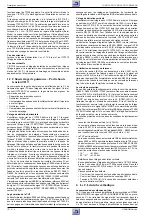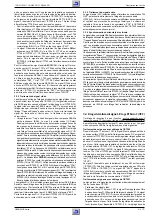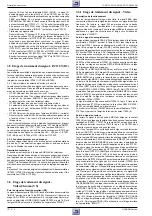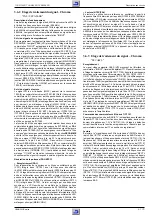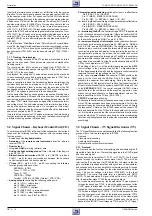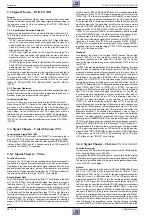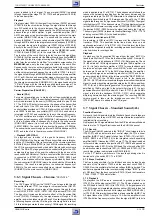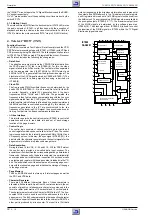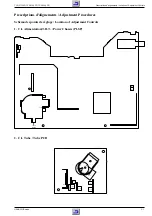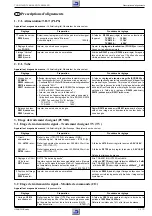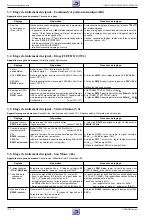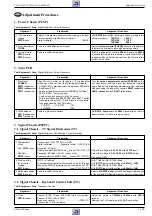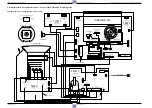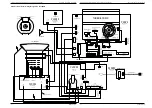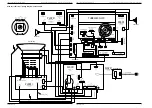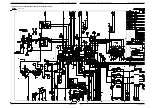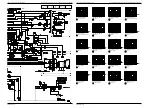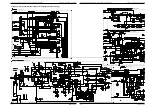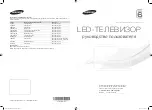
k
2 - 16
GRUNDIG Service
Description
TVR 3710 FR, TVR 5100 FR, TVR 5500 FR
the "IN/OUT" circuit stage to the TV Signal Electronics and the EURO-
AV socket respectively.
On "LP" mode, switchover of the equalizing circuit is carried out by the
switch EP CTL.
3.7.4 Muting Circuit
The mute command (MTA) from the deck computer IC7410-(40) mutes
the audio outputs of IC7601 in all functions, with the exception of
playback and record, and also in the case of servo faults. For this, the
IC7601 obtains the mute command "MTA" via pin 22 (HIGH active).
word corresponding to the brightness information and is present at
the output of the ROM after every 1
µ
s. This data word is entered into
a shift register and is read out at a 12MHz pixel clock derived from
the 6MHz clock. The corresponding R/G/B signals are available at
the push-pull outputs IC7880-(15…17). The maximum output level
of the R/G/B signals is determined by the voltage present on
IC7880-(18). The blank signal from IC7880-(19) is used to control
the insertion of the R/G/B signals in IC7200 within the TV Signal
Electronics (signal chassis).
4. Teletext "DOS" (TXT)
Function Overview
The DOS unit contains a Test Pattern / Data Generator and the VPS/
PDC/Teletext processing stage with IC7881 or IC7880 (with VPS and
PDC processing) being the heart of it. The following description refers
to IC7880. This IC7880, named IVT (Integrated Video-Input-Processor
and Teletext) includes the following function groups:
– Data Slicer
The adaptive data slicer extracts the VPS/PDC/teletext data from
the CCVS signal (VTV) fed in via IC7880-(8). For this, the video
signal is taken to an A/D converter. The text data is then separated
and the appropriate clock (6.9375MHz for PDC/Teletext and
2.5MHz for VPS ) is generated from the digitised video signal. The
black level of the CCVS signal is stored by C2888 at IC7880-(7). The
reference current for analog signal processing is derived via
IC7880-(9).
– Clock-PLL
The free-running 27MHz oscillator frequency is determined by the
quartz Q1800 at IC7880-(2…4) and is used first of all for the A/D
converter. Secondly, a digital PLL generates from it the basic
frequencies 6MHz, 1MHz, and 15.625kHz. The generated line
frequency is then fed to a phase comparator along with the line sync
signals separated from the CCVS signal. The characteristic of the
digital loop filter which follows is influenced by a control register and
the 6MHz oscillator is controlled accordingly. By this method, all
frequencies generated in the IVT are synchronized to the line
frequency of the incoming CCVS signal. In unsynchronized condi-
tion (eg. test pattern) no phase comparison takes place.
– I
2
C-bus Interface
This interface permits the central computer (IC7880) to control all
operations and also to read data into and out of each storage
location of the page memory.
– Control Logic
The control logic consists of various counters, gate circuits and
control registers which can be controlled via the I
2
C-bus. The control
logic is supplied with the internally generated 6MHz, 1MHz, H and
V-frequency pulses. In this way, the sync signal (IC7880-(12)), the
pixel clock for the character generator, and the control signals for the
page memory interface are produced among others.
– Data Acquisition
During the lines 16 for VPS, 2…22 and 315…335 for PDC/Teletext
the control logic provides a so-called data input window. The
acquisition circuit identifies the corresponding data by a determined
frame code. Subsequently, the data is subjected to a serial/parallel
conversion and an error detection or correction. When the user calls
up a text page a register with the page number is loaded via the I
2
C-
bus. The acquisition circuit then compares all incoming page num-
bers with the requested page and initializes the storage of the page
in the page memory.
– Page Memory
The 8k x 8-DRAM is used to store up to 8 teletext pages as well as
the PDC and VPS data.
– Character Generator
There are 256 different characters. Each of these characters is
allocated a 8bit data word. Apart from 32 control characters, the set
consists of graphic or alphanumeric characters composed in the
form of a raster point matrix of 12 horizontal and 10 vertical points.
The characters are stored in the Character ROM in the IVT. The line-
coupled 1MHz clock is used to switch the addresses fed in to the
page memory. The 8bit code representing the respective character
in turn forms one part of the address fed in to the character ROM. The
other part is produced by a line counter. The result is a 12bit data
IC7880
SAA5281
Line Counters
and Display
Acquisition
Oscillator
/2
8k Memory
Character Generator Buffers
Character ROM
ODD/EVEN OR DV
Digital PLL
and processing
Sync separation
and Acquisition
Data slicing
AD-Conversion
Clamp
Control Registers
I2C Businterface
37
38
39
40
41
42
43
44
45
46
47
48
1
2
3
4
4
5
6
7
8
9
10
11
12
13
14
15
16
17
18
19
20
21
22
23
24
25
26
27
28
29
30
31
32
33
34
35
36
Summary of Contents for TVR 3710 FR
Page 16: ...Partie g n rale General Section TVR 3710 FR TVR 5100 FR TVR 5500 FR 1 16 GRUNDIG Service Notes...
Page 91: ...TVR 3710 FR TVR 5100 FR TVR 5500 FR Vues clat es Exploded Views GRUNDIG Service E 3 3...
Page 92: ...Vues clat es Exploded Views TVR 3710 FR TVR 5100 FR TVR 5500 FR E 4 GRUNDIG Service 4...

